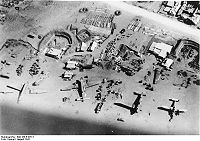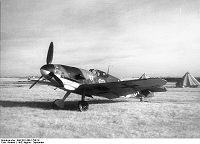- Operation Albumen
-
Operation Albumen was the name given to British Commando raids in June 1942, on German airfields in the Axis-occupied Greek island of Crete, to prevent them from being used for supporting the Afrika Korps in the Western Desert Campaign in World War II. These operations were carried out in tandem with similar raids against Axis airfields at Benghazi, Derna and Barca in Libya[1] and were among the very first planned sabotage acts in occupied Europe.
Contents
Overview
During the late spring of 1942, the airfields of Crete gained increased strategic importance by becoming the main transit base for Luftwaffe to supply logistic support to Rommel's Afrika Korps in their advance on the Nile Delta. Furthermore, Luftwaffe aircraft based on Crete operated photo-reconnaissance, bombing and convoy attack missions covering the south-east Mediterranean region. Aiming to disrupt these operations, British generals in Cairo sent to Crete three groups from the Special Boat Squadron (SBS) and one from Stirling's Special Air Service (SAS) with the mission to sabotage the airfields of Heraklion, Kastelli Pediados, Tympaki and Maleme.[2]
Aircraft types operating from Crete at the time included the Ju 52 and Me 323 for transport, the Ju 88 and Ju 86 for bombing and photo-reconnaissance and the Bf 109 as a fighter.
Heraklion airfield was allocated to the SAS group whereas the SBS groups were assigned to the other three airfields. The SBS groups were met by Tom Dunbabin, the British liaison officer with the Cretan resistance, who provided them with local guides. The date for all sabotages was scheduled as the night of the 7th and 8th of June, 1942.
Kastelli operation
The squad to attack Kastelli consisted of Irish captain G.I.A. Duncan of the Black Watch, two British NCOs of the SBS and the Greek gendarme Vassilis Dramoundanis. The operation unfolded according to plan and on June 7, the saboteurs assisted by the locals Giorgos Psarakis, Kimonas Zografakis and Kostas Mavrantonakis, managed to destroy 5 aircraft, damage 29 other and arson several vehicles and considerable quantities of supplies (including about 200 tons of aviation fuel) using delayed action bombs.[3]
The June 1942 operation is often referred to as the first raid on Kastelli to differentiate it from a second, similar operation that took place a year later. One of the objectives of this second operation was to lead the Germans into believing that an Allied landing on Crete (rather than their true target Sicily) was imminent. Thus, on the night of July 4 to July 5 1943, two commando groups under the Danish major Anders Lassen and the Greek Kimonas Zografakis, simultaneously attacked the airfield of Kastelli from two different locations. Despite the strong security, they succeeded in deceiving the garrison and destroying most of the parked aircraft and fuel dumps.[4] [5]
Heraklion operation
 Ju 88 over Astypalaia in 1943.
Ju 88 over Astypalaia in 1943.
The Heraklion operation was commanded by George Jellicoe and included four members of the Free French Forces under Georges Bergé (the other three being Jacques Mouhot, Pierre Léostic and Jack Sibard) and lieutenant Kostis Petrakis of the Hellenic Army. Things went out of plan for the party of six saboteurs which were transferred to Crete on board the Greek submarine Triton: rowing in three inflatable boats, they set ashore in the Gulf of Malia on the dawn of June 10, further east from the intended Karteros beach and behind schedule.[6] Spending the days hiding and the nights marching, they reached Heraklion airfield on the night of 12 to 13 of June. However, they were unable to mount an assault due to the increased traffic caused by a succession of night sorties that was in progress. Eventually, the attack took place on the night of June 13, when the group managed to enter the area of the airfield while it was being bombed by the RAF. In total, about 20 aircraft (Ju 88) were destroyed using Lewes bombs. While all six saboteurs managed to escape from the airfield, their retreat was betrayed resulting in 17-yr old Pierre Léostic being killed and the other three French being arrested. Jellicoe and Petrakis managed to escape to Egypt.[7] [8]
Tympaki operation
The Tympaki team (led by David Sutherland of the Black Watch) discovered that due to air raids from Egypt, the airfield had been temporarily abandoned and the aircraft based there had been relocated.
Maleme operation
The Maleme team was also unsuccessful. They found out that the airfield was strongly guarded and was recently equipped with electrified fences, making it impossible to penetrate its perimeter.
Aftermath
As a result of the raids, over 25 aircraft were completely destroyed and 12 German soldiers died. In reprisal to the sabotage in Heraklion, the occupation forces executed 50 inhabitants of the greater Heraklion area on the next day, June 14. A few days earlier (June 3), the Germans had executed another 12 Heraklion citizens. The Avenue of the 62 Martyrs (Greek: Λεωφόρος 62 Μαρτύρων) in modern Heraklion is named in remembrance of the victims.
On June 23, Jellicoe, Petrakis and the participants of the Kastelli and Tympaki operations were evacuated to Mersa Matruh, Egypt on a caique from Trypiti beach near the village of Krotos in south Crete. They reached Mersa Matruh shortly before it fell to Rommel's advancing forces. Jellicoe was later awarded the DSO. After several days of interrogations under the threat of execution, Bergé, Mouhot and Sibard who were captured after the Heraklion sabotage, were transferred to the Oflag X-C war prisoner camp in Germany. Eventually, Bergé ended up in Colditz castle, the Saxon fortress where prisoners that had repeatedly attempted to escape were held. There, Bergé joined SAS commander David Stirling who had been captured in the mean time. To honor the memory of Pierre Léostic, Kostis Petrakis christened his son after him.
The failure to prevent the raids on the airfields was one of the reasons that led to the replacement of General Alexander Andrae by Bruno Bräuer as commander of Crete.
See also
References
- ^ S.A.S. Raids in North Africa 1941 - 1942
- ^ Beevor, Antony. Crete: The Battle and the Resistance, John Murray Ltd, 1991. Penguin Books, 1992.
- ^ Ο Γερμανός επιλοχίας θυμάται, Πατρίς onLine, 27 Μαρτίου 2003.
- ^ Β' σαμποτάζ Αεροδρομίου Καστελίου: 4-5 Ιουλίου 1943, Πατρίς onLine, 1 Ιουλίου 2003.
- ^ Thompson, Leroy. SAS: Great Britain's Elite Special Air Service, Zenith Press, ISBN 9780879389406, 1994.
- ^ Το Σαμποτάζ στο αεροδρόμιο Ηρακλείου, Πατρίς onLine, 21 Ιουνίου 2005.
- ^ Sibard, Jack L. Mission En Crete, Société des Etudes Historiques Crétoises, ISBN 9789608717053, 2006.
- ^ Σανουδάκης, Αντώνης. Ιππότες του ονείρου. Αφήγηση Κωστή Πετράκη, εκδόσεις Κνωσός, ISBN 9789602070093, 1989.
External links
- Earl Jellicoe interviewed, also describes Heraklion operation
- Heraklion operation from France Libre (in French -- translate)
- Obituary: General Georges Berge
- Sabotage /62: Historical Museum of Crete (in Greek -- translate)
Greece during World War II 1940–41 Balkans Campaign Occupation and Resistance Greek government in exile Battles: Elaia–Kalamas · Pindus · Morava–Ivan · Klisura · Trebeshina · Italian Spring Offensive
Commanders:
 Greece
Greece
Ioannis Metaxas · Alexander Papagos · Charalambos Katsimitros
 Italy
Italy
Sebastiano Visconti Prasca · Ubaldo Soddu · Ugo Cavallero · Giovanni MesseBattles: Metaxas Line · Vevi · Kleisoura Pass · Thermopylae · Crete
Commanders:
 Greece
Greece
Alexander Papagos · Georgios Tsolakoglou
 British Expeditionary Corps
British Expeditionary Corps
Henry Maitland Wilson · Thomas Blamey · Bernard Freyberg
 Germany
Germany
Wilhelm List · Kurt StudentOccupying powersOccupation Authorities:
 Germany
Germany
Günther Altenburg · Hermann Neubacher · Walter Schimana · Alexander Löhr · Hellmuth Felmy
 Italy
Italy
Pellegrino Ghigi · Carlo Geloso
 Bulgaria
BulgariaAtrocities: Kondomari · Kandanos · Doxato · Kommeno · Kalavryta · Distomo · Domenikon · Drakeia · Cephalonia · Paramythia · Mesovouno · Pyrgoi · Viannos · Kedros · Chortiatis · The Holocaust in Greece · Great Famine
CollaboratorsPeople: Georgios Tsolakoglou · K. Logothetopoulos · Ioannis Rallis · Georgios Poulos
Organizations: Collaborationist government · Security Battalions · ESPO · EEE · Greek National Socialist Party
Secessionists: Principality of the Pindus · Ohrana · Cham collaboration (Këshilla)
People: Aris Velouchiotis · Stefanos Sarafis · Georgios Siantos · Markos Vafiades · Evripidis Bakirtzis · Andreas Tzimas
Organizations: KKE · ELAS · PEEA · EPON · E.A. · OPLA · SNOF
Operations: Ryka · Mikro Chorio · Gorgopotamos Bridge · Fardykambos · Sarantaporo · Kournovo Tunnel
Non-EAM ResistancePeople: Napoleon Zervas · Georgios Kartalis · Dimitrios Psarros · Komninos Pyromaglou · Alexander Papagos · Kostas Perrikos · George Psychoundakis
Organizations: EDES · EKKA · YVE/PAO · PEAN · ΕΟΚ · E.S. · MAVI · Other
Operations: ESPO bombing · Gorgopotamos Bridge · Fardykambos · Agia Kyriaki · Milia · Skala Paramythias · Xirovouni · Menina · Dodona
Atrocities: Expulsion of Cham Albanians
British Mission in Greece (SOE)People: Eddie Myers · Chris Woodhouse · Patrick Leigh Fermor · Bill Stanley Moss
Operations: Operation "Albumen" · Gorgopotamos Bridge · Operation "Animals" · Asopos Bridge · Kidnap of General Kreipe · Damasta sabotage
Events: El Alamein · Dodecanese · April 1944 mutiny · Rimini
People: King George II · Emmanouil Tsouderos · Panagiotis Kanellopoulos
Notable units: 3rd Mountain Brigade · Sacred Band · Vasilissa Olga · Adrias · Katsonis · Papanikolis · 13th Squadron · 335th Squadron · 336th Squadron
Towards the Civil WarEvents: Plaka agreement · Lebanon conference · Caserta agreement · Percentages agreement · Dekemvriana · Treaty of Varkiza
People: Ronald Scobie · George Papandreou · Archbishop Damaskinos
 British Commando raids of the Second World War
British Commando raids of the Second World WarA Abstention · Agreement · Ambassador · Anklet · Archery · Aquatint · Aflame · Anglo · Amherst · Archway · Abercrombie · Acid Drop · Albumen · AstrakanB C D E ExporterF G H Hardtack · Huckaback · Hawthorn · Houndsworth
I J K L M N P R Rimau · Roast · Roundabout · Rumford
S T British Commandos · List of Commando raids on the Atlantic wall Categories:- Conflicts in 1942
- Acts of sabotage
- Crete in World War II
- Greek Resistance
- Military history of the United Kingdom during World War II
- World War II Mediterranean Theatre
- Special Air Service
- 1942 in Greece
- World War II British Commando raids
Wikimedia Foundation. 2010.




